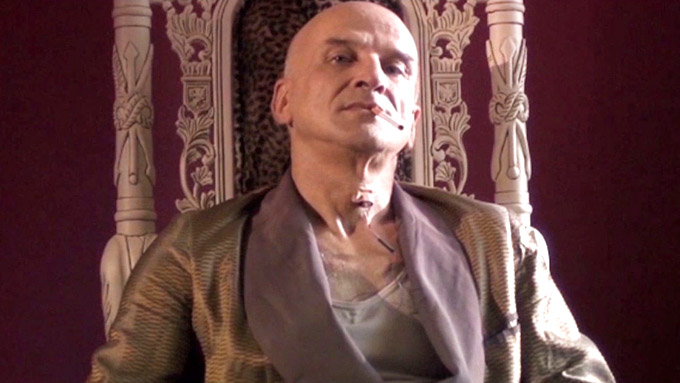Year: 1965
Aka: Il tesoro della foresta pietrificata, Le tresor de la foret noire
Length: 90 mins
Country: Italy
Cinematography: {Asterscope – Eastmancolor}
Produced by Emimmo Salvi for Avis Film, Asteria and Olga Chart (Rome)
Distribution: Regional
Director: Emimmo Salvi
Story: Emimmo Salvi
Screenplay: Adriano Antonelli, Benito Ilforte, Emimmo Salvi, Luigi Tosi
Cinematography: Mario Parapetti Music: Ralph Ferraro
Editor: Enzo Alfonsi
Art direction: Giuseppe Ranieri
Cast: Gordon Mitchell (Hunding), Ivo Payer [Ivica Pajer] (Sigmund), Eleanora Bianchi (Siglinde), Pamela Tudor, Mike Moore [Amedeo Trilli], Nat Koster [Nat Coster], Puccio [Pietro] Ceccarelli, Franco Doria, Attilio Severini, Franco Beltramme, Lella Cattaneo, Lia Giordano, Giorgio Tesei, Ivan Scratuglia, Luisa Rivelli (Erika).
Uncredited: Veriano Genesi, Luigi Tosi
Having worked his wayward magic with both Roman and Arabian mythology in Vulcan Son of Jupiter, The Seven Tasks of Ali Baba and Sinbad and the Seven Saracens, director Emimmo Salvi obviously felt the need to explore new ground with his next peplum, Treasure of the Petrified Forest. So he turned to the ancient Eddas, the tales of Norse Gods and heroes that had been handed down from Viking times, and had also proved inspiration for both The Lord of the Rings and Wagner’s Ring Cycle. The results, unsurprisingly, are strange. Anyone hoping for a faithful representation of the ancient legends will be sorely disappointed: Salvi’s interpretation of Norse mythology is far from slavish to the original, and the familiar components are bent to fit into a more traditional peplum format
Sigmund (Ivo Payer), the young Prince of Valhalla does his best to be a level handed ruler. However, he has a big problem on his hands: Vikings, led by the aggressive Hunding (Gordon Mitchell), are causing problems on the borders, looking ever more likely to try an invasion. They’re desperate to get their hands on some secret treasure, the possession of which is supposed to grant absolute power, that is buried at the other end of the ‘black forest’, a mysterious terrain at the heart of Valhalla. But only Sigmund and his sister, Brunhilde (Pamela Tudor), the leader of a tribe of female warriors called The Valkyrie, know the correct way through it, and without their guidance nobody who has ever entered has emerged alive again.
Hunding, however, finds an ally in Erika (Luisa Rivelli), the daughter of one of Sigmund’s most trusted men, who hates the Prince for spurning her affections and also happens to know the whereabouts of the hidden treasure. With her help, the Vikings are able to attack the Valhallan camp, killing everyone before heading on into the forest, an act that so enrages Sigmund that he vows to have revenge, taking his few remaining men and setting off on their trail. Hunding, however, proves to be a more than capable adversary and, with the help of further traitors in the Valhallan ranks, is able to capture both Sigmund and his girlfriend, Siglinde (Eleanora Bianchi), who just happens to be Erika’s sister.
Perhaps Salvi’s ambition – both Wagner and Tolkein took hours to tell their epic tales, whereas this lasts approximately 90 minutes – should be applauded, but it also makes for an astonishingly complicated film, especially during the first half hour. Even within its own terms, elements are often self-contradictory: the ‘black forest’, for instance, is also called the ‘petrified forest’ on occasion, despite their being little evidence of any kind of petrification among the shrubbery. Valhalla is sometimes portrayed as a country, but then is also referred to in it’s more traditional sense, as a destination for slain warriors. And the nature of the relationship between the Vikings and the Valhallans is never made clear: are the Valhallans Vikings? Are the Vikings really Vikings, or are they simply a group of renegade bandits?
After about thirty minutes or so, the urge to make any kind of sense out of the story has just about dissipated, and things settle down into a mildly diverting, traditional adventure film, with Sigmund and Hunding squaring off repeatedly while minor characters do their stuff in the background. Unfortunately, there’s not really much in the way of plot development, and the pace is occasional drawn to a halt by repeated, chaotic and frankly quite boring battle sequences. There are a few minor avenues of interest – the Valkyries are a curious, intangible bunch, there are a couple of rickety ‘antique’ gadgets – but otherwise it’s all much of a muchness.
Salvi throws in some of his trademark touches, such as dwarf baiting and some wilfully histrionic acting. Although it’s all supposedly set in the forest, a large proportion was shot in Cinecitta, and again the direction makes good use of the interiors, creating a heightened sense of unreality through unusual art direction and set design. Some sequences, with sparse trees shrouded in dry ice, actually have a surprisingly gothic touch, not too different to the type of thing that Mario Bava was shooting at the time. Unfortunately, though, despite his best efforts, Salvi was dealing with a genre that was already a considerable way past its sell by date and, although it’s better than Sinbad and the Seven Saracens, Salvi’s poorest film, it’s nowhere near as diverting as Vulcan Son of Jupiter or The Seven Tasks of Ali Baba.
Gordon Mitchell, in his third film under Salvi’s direction, is good fun as the utterly despicable villain, but possibly the most nuanced performance comes from Luisa Rivelli, who had made her name in a series of b-movies and melodramas throughout the 1950s. Ivo Payer was a Yugoslavian actor who appeared in a handful of peplums (he was formerly in the Salvi production David and Goliath). He’s not bad, but his thespian talents skills don’t come near distracting attention from the quite appalling bouffant hairstyle he’s been landed with.
